NURSING 2: Atrial Fibrillation Care Plan, Discharge and Medication
VerifiedAdded on 2022/08/21
|12
|3233
|12
Report
AI Summary
This report presents a comprehensive nursing care plan for a 42-year-old patient, Mr. Robert, admitted with Atrial Fibrillation (AF). The report begins with a definition of AF, its pathophysiology, and how the patient's past medical history, including T2DM, HTN, and smoking, relates to his current condition. Task 2 details a nursing care plan addressing the risks of infection, impaired tissue perfusion, and knowledge deficits, including goals, interventions, rationales, and evaluations. Task 3 focuses on a discharge plan, emphasizing patient education on medication, lifestyle adjustments, and stroke awareness. Task 4 provides information on the medications Digoxin and Ramipril, including their uses, mechanisms of action, and potential side effects. The report aims to provide a holistic approach to patient care, ensuring both immediate well-being and long-term health management.
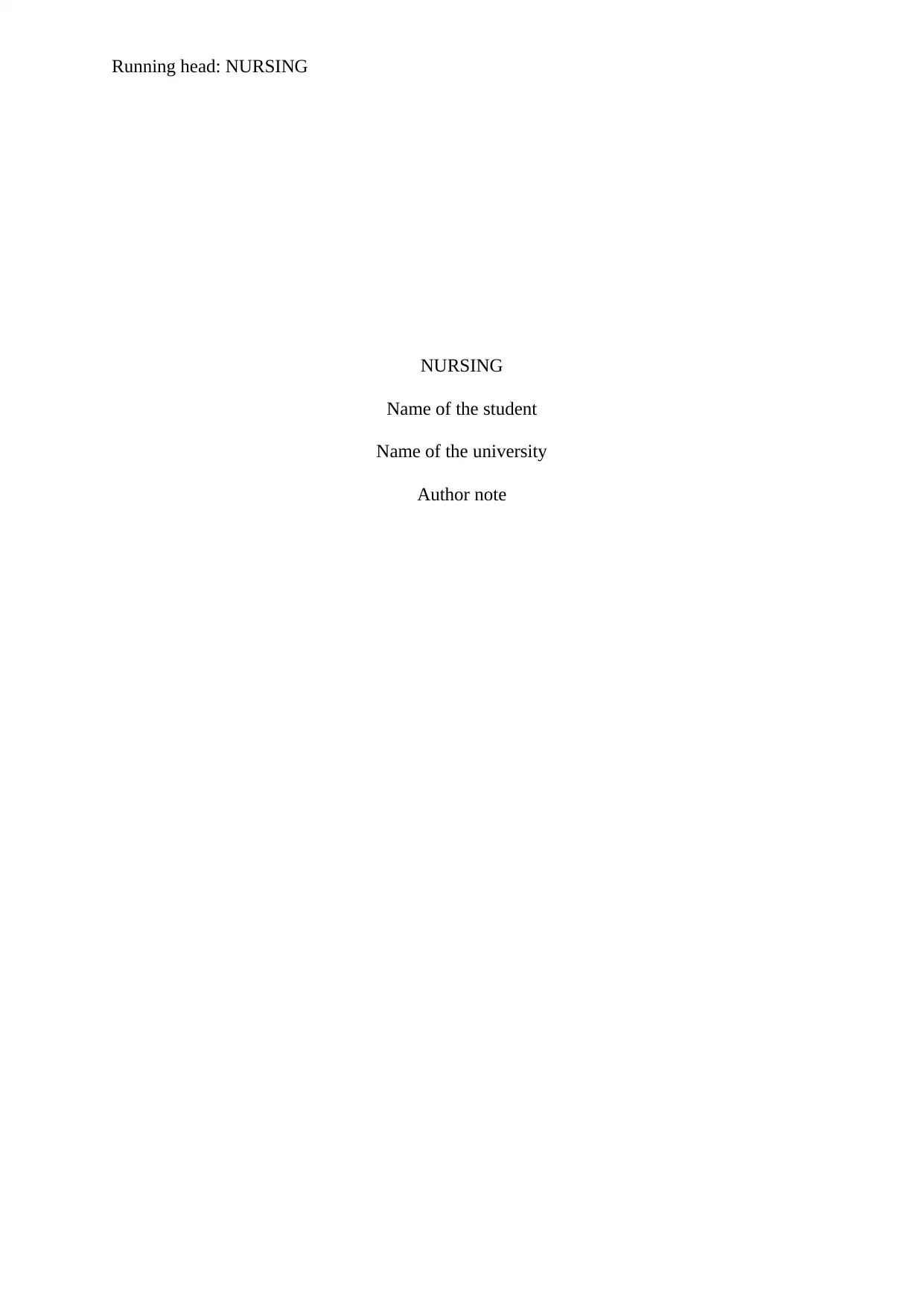
Running head: NURSING
NURSING
Name of the student
Name of the university
Author note
NURSING
Name of the student
Name of the university
Author note
Paraphrase This Document
Need a fresh take? Get an instant paraphrase of this document with our AI Paraphraser
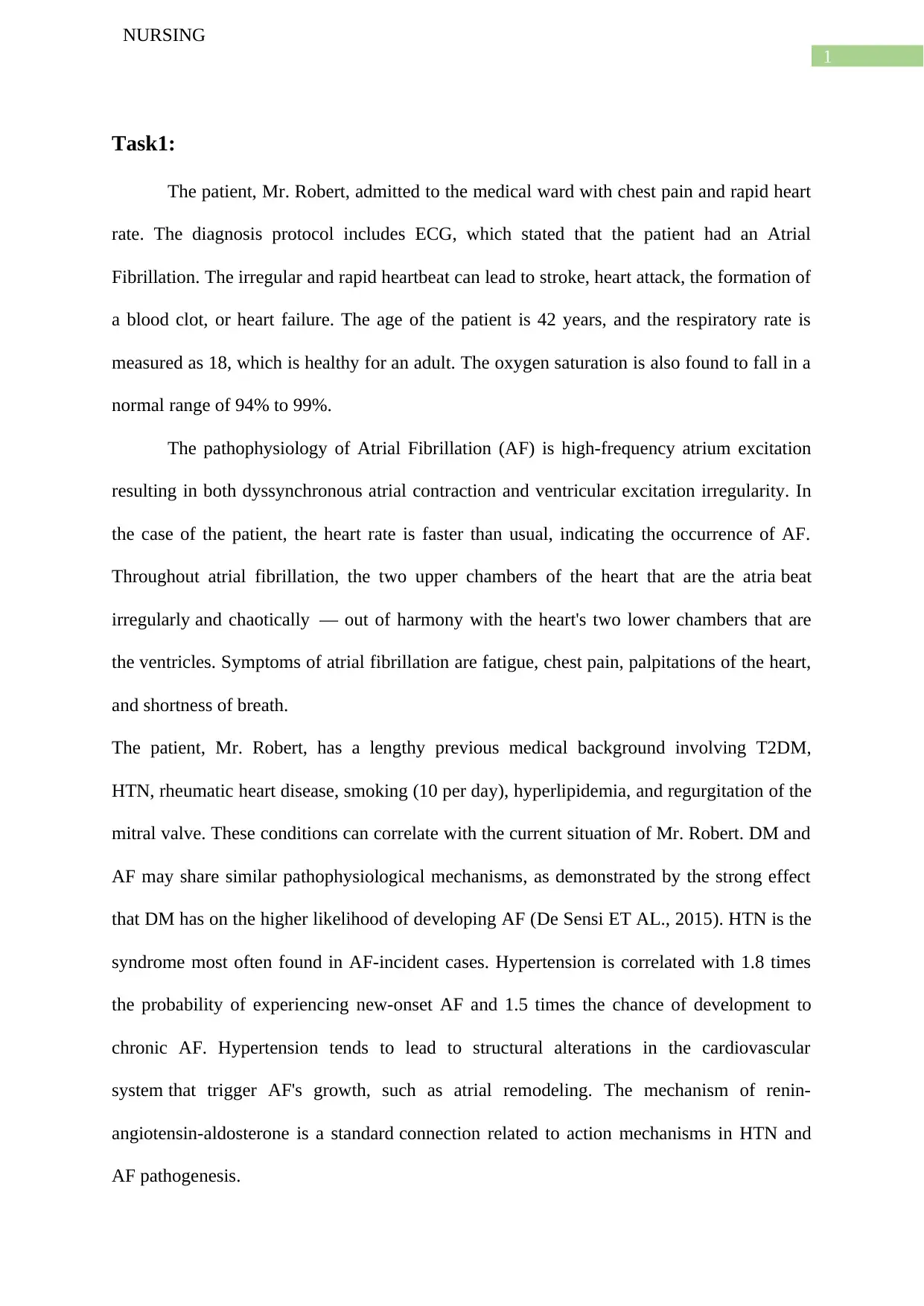
1
NURSING
Task1:
The patient, Mr. Robert, admitted to the medical ward with chest pain and rapid heart
rate. The diagnosis protocol includes ECG, which stated that the patient had an Atrial
Fibrillation. The irregular and rapid heartbeat can lead to stroke, heart attack, the formation of
a blood clot, or heart failure. The age of the patient is 42 years, and the respiratory rate is
measured as 18, which is healthy for an adult. The oxygen saturation is also found to fall in a
normal range of 94% to 99%.
The pathophysiology of Atrial Fibrillation (AF) is high-frequency atrium excitation
resulting in both dyssynchronous atrial contraction and ventricular excitation irregularity. In
the case of the patient, the heart rate is faster than usual, indicating the occurrence of AF.
Throughout atrial fibrillation, the two upper chambers of the heart that are the atria beat
irregularly and chaotically — out of harmony with the heart's two lower chambers that are
the ventricles. Symptoms of atrial fibrillation are fatigue, chest pain, palpitations of the heart,
and shortness of breath.
The patient, Mr. Robert, has a lengthy previous medical background involving T2DM,
HTN, rheumatic heart disease, smoking (10 per day), hyperlipidemia, and regurgitation of the
mitral valve. These conditions can correlate with the current situation of Mr. Robert. DM and
AF may share similar pathophysiological mechanisms, as demonstrated by the strong effect
that DM has on the higher likelihood of developing AF (De Sensi ET AL., 2015). HTN is the
syndrome most often found in AF-incident cases. Hypertension is correlated with 1.8 times
the probability of experiencing new-onset AF and 1.5 times the chance of development to
chronic AF. Hypertension tends to lead to structural alterations in the cardiovascular
system that trigger AF's growth, such as atrial remodeling. The mechanism of renin-
angiotensin-aldosterone is a standard connection related to action mechanisms in HTN and
AF pathogenesis.
NURSING
Task1:
The patient, Mr. Robert, admitted to the medical ward with chest pain and rapid heart
rate. The diagnosis protocol includes ECG, which stated that the patient had an Atrial
Fibrillation. The irregular and rapid heartbeat can lead to stroke, heart attack, the formation of
a blood clot, or heart failure. The age of the patient is 42 years, and the respiratory rate is
measured as 18, which is healthy for an adult. The oxygen saturation is also found to fall in a
normal range of 94% to 99%.
The pathophysiology of Atrial Fibrillation (AF) is high-frequency atrium excitation
resulting in both dyssynchronous atrial contraction and ventricular excitation irregularity. In
the case of the patient, the heart rate is faster than usual, indicating the occurrence of AF.
Throughout atrial fibrillation, the two upper chambers of the heart that are the atria beat
irregularly and chaotically — out of harmony with the heart's two lower chambers that are
the ventricles. Symptoms of atrial fibrillation are fatigue, chest pain, palpitations of the heart,
and shortness of breath.
The patient, Mr. Robert, has a lengthy previous medical background involving T2DM,
HTN, rheumatic heart disease, smoking (10 per day), hyperlipidemia, and regurgitation of the
mitral valve. These conditions can correlate with the current situation of Mr. Robert. DM and
AF may share similar pathophysiological mechanisms, as demonstrated by the strong effect
that DM has on the higher likelihood of developing AF (De Sensi ET AL., 2015). HTN is the
syndrome most often found in AF-incident cases. Hypertension is correlated with 1.8 times
the probability of experiencing new-onset AF and 1.5 times the chance of development to
chronic AF. Hypertension tends to lead to structural alterations in the cardiovascular
system that trigger AF's growth, such as atrial remodeling. The mechanism of renin-
angiotensin-aldosterone is a standard connection related to action mechanisms in HTN and
AF pathogenesis.
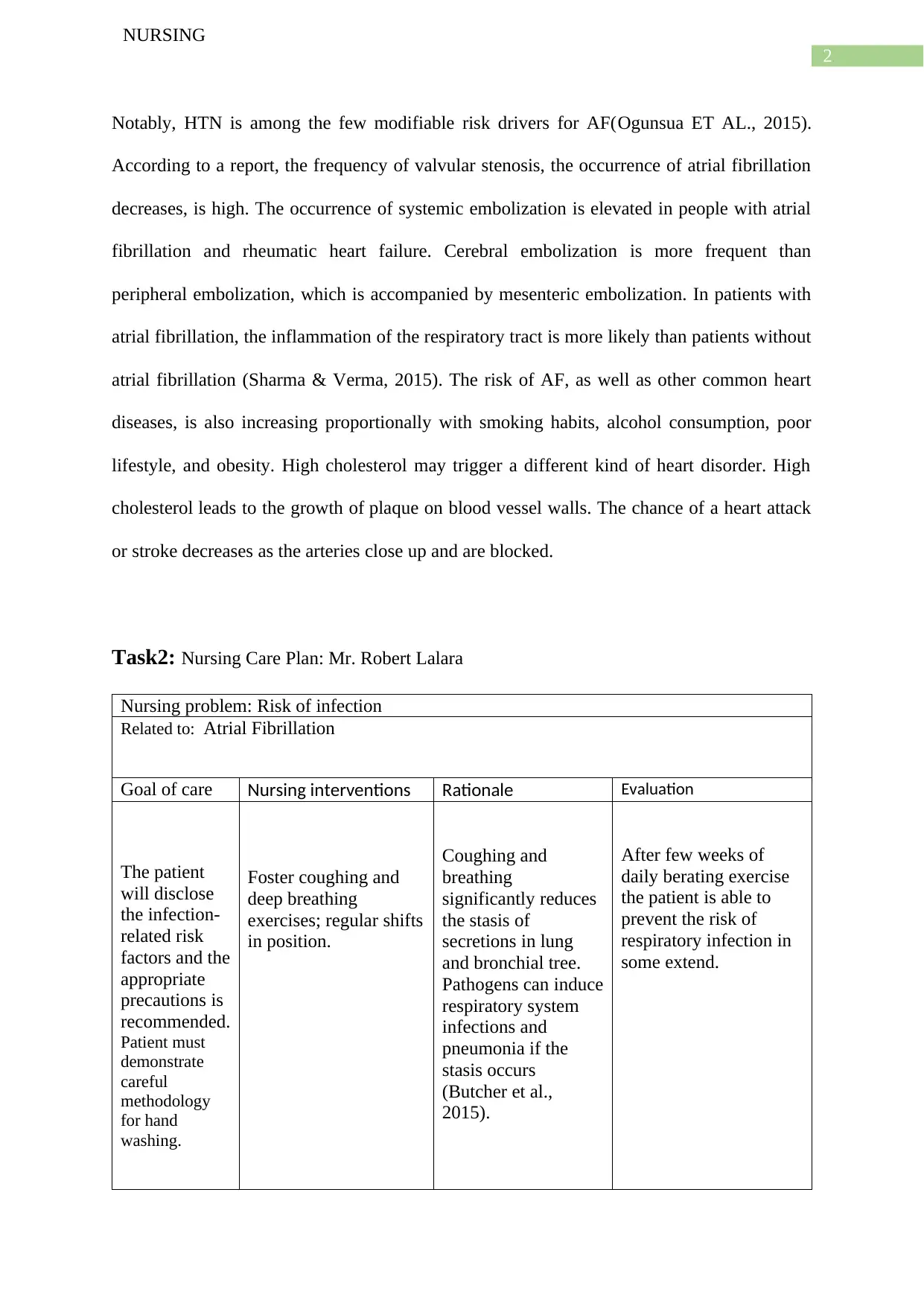
2
NURSING
Notably, HTN is among the few modifiable risk drivers for AF(Ogunsua ET AL., 2015).
According to a report, the frequency of valvular stenosis, the occurrence of atrial fibrillation
decreases, is high. The occurrence of systemic embolization is elevated in people with atrial
fibrillation and rheumatic heart failure. Cerebral embolization is more frequent than
peripheral embolization, which is accompanied by mesenteric embolization. In patients with
atrial fibrillation, the inflammation of the respiratory tract is more likely than patients without
atrial fibrillation (Sharma & Verma, 2015). The risk of AF, as well as other common heart
diseases, is also increasing proportionally with smoking habits, alcohol consumption, poor
lifestyle, and obesity. High cholesterol may trigger a different kind of heart disorder. High
cholesterol leads to the growth of plaque on blood vessel walls. The chance of a heart attack
or stroke decreases as the arteries close up and are blocked.
Task2: Nursing Care Plan: Mr. Robert Lalara
Nursing problem: Risk of infection
Related to: Atrial Fibrillation
Goal of care Nursing interventions Rationale Evaluation
The patient
will disclose
the infection-
related risk
factors and the
appropriate
precautions is
recommended.
Patient must
demonstrate
careful
methodology
for hand
washing.
Foster coughing and
deep breathing
exercises; regular shifts
in position.
Coughing and
breathing
significantly reduces
the stasis of
secretions in lung
and bronchial tree.
Pathogens can induce
respiratory system
infections and
pneumonia if the
stasis occurs
(Butcher et al.,
2015).
After few weeks of
daily berating exercise
the patient is able to
prevent the risk of
respiratory infection in
some extend.
NURSING
Notably, HTN is among the few modifiable risk drivers for AF(Ogunsua ET AL., 2015).
According to a report, the frequency of valvular stenosis, the occurrence of atrial fibrillation
decreases, is high. The occurrence of systemic embolization is elevated in people with atrial
fibrillation and rheumatic heart failure. Cerebral embolization is more frequent than
peripheral embolization, which is accompanied by mesenteric embolization. In patients with
atrial fibrillation, the inflammation of the respiratory tract is more likely than patients without
atrial fibrillation (Sharma & Verma, 2015). The risk of AF, as well as other common heart
diseases, is also increasing proportionally with smoking habits, alcohol consumption, poor
lifestyle, and obesity. High cholesterol may trigger a different kind of heart disorder. High
cholesterol leads to the growth of plaque on blood vessel walls. The chance of a heart attack
or stroke decreases as the arteries close up and are blocked.
Task2: Nursing Care Plan: Mr. Robert Lalara
Nursing problem: Risk of infection
Related to: Atrial Fibrillation
Goal of care Nursing interventions Rationale Evaluation
The patient
will disclose
the infection-
related risk
factors and the
appropriate
precautions is
recommended.
Patient must
demonstrate
careful
methodology
for hand
washing.
Foster coughing and
deep breathing
exercises; regular shifts
in position.
Coughing and
breathing
significantly reduces
the stasis of
secretions in lung
and bronchial tree.
Pathogens can induce
respiratory system
infections and
pneumonia if the
stasis occurs
(Butcher et al.,
2015).
After few weeks of
daily berating exercise
the patient is able to
prevent the risk of
respiratory infection in
some extend.
⊘ This is a preview!⊘
Do you want full access?
Subscribe today to unlock all pages.

Trusted by 1+ million students worldwide
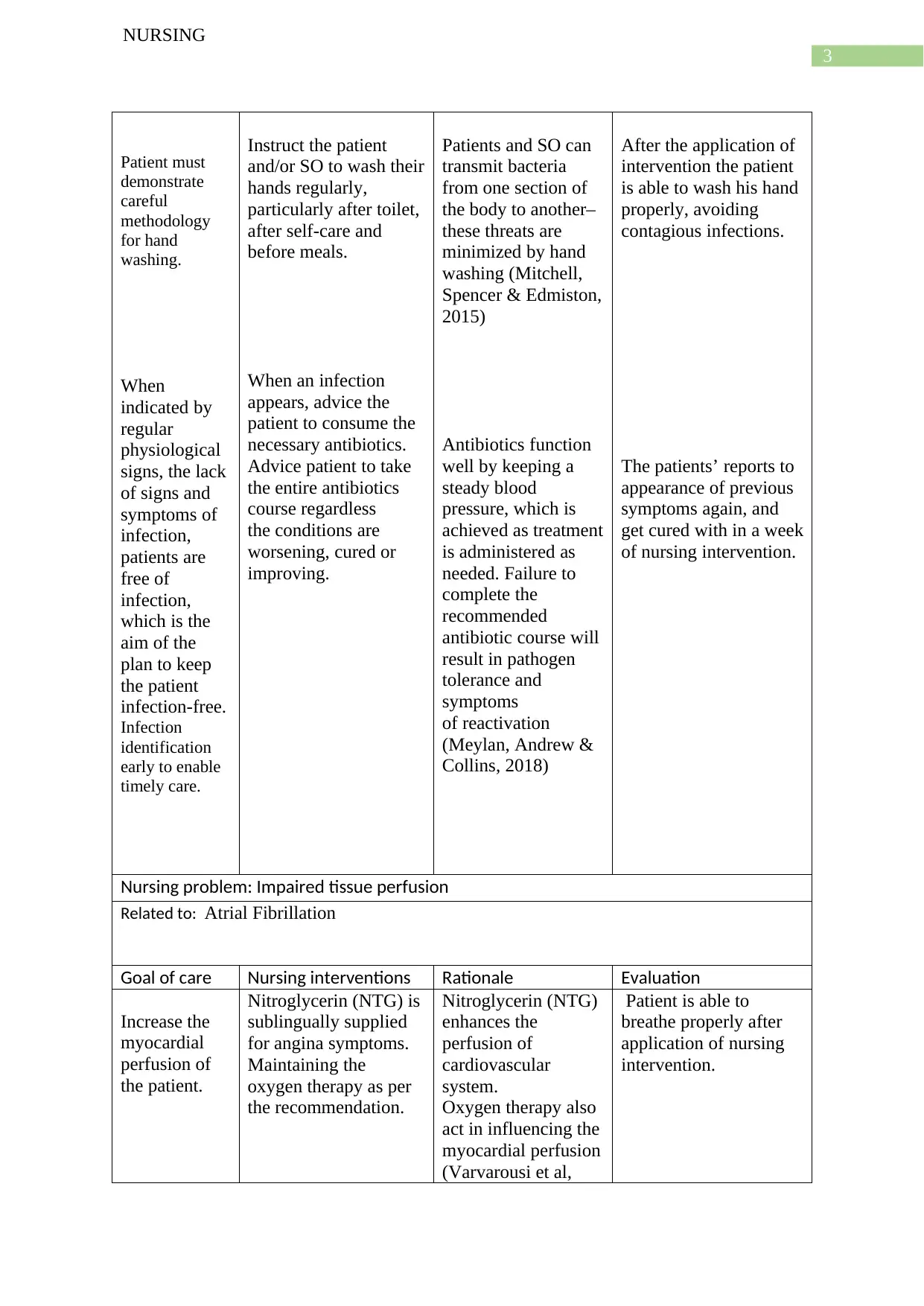
3
NURSING
Patient must
demonstrate
careful
methodology
for hand
washing.
When
indicated by
regular
physiological
signs, the lack
of signs and
symptoms of
infection,
patients are
free of
infection,
which is the
aim of the
plan to keep
the patient
infection-free.
Infection
identification
early to enable
timely care.
Instruct the patient
and/or SO to wash their
hands regularly,
particularly after toilet,
after self-care and
before meals.
When an infection
appears, advice the
patient to consume the
necessary antibiotics.
Advice patient to take
the entire antibiotics
course regardless
the conditions are
worsening, cured or
improving.
Patients and SO can
transmit bacteria
from one section of
the body to another–
these threats are
minimized by hand
washing (Mitchell,
Spencer & Edmiston,
2015)
Antibiotics function
well by keeping a
steady blood
pressure, which is
achieved as treatment
is administered as
needed. Failure to
complete the
recommended
antibiotic course will
result in pathogen
tolerance and
symptoms
of reactivation
(Meylan, Andrew &
Collins, 2018)
After the application of
intervention the patient
is able to wash his hand
properly, avoiding
contagious infections.
The patients’ reports to
appearance of previous
symptoms again, and
get cured with in a week
of nursing intervention.
Nursing problem: Impaired tissue perfusion
Related to: Atrial Fibrillation
Goal of care Nursing interventions Rationale Evaluation
Increase the
myocardial
perfusion of
the patient.
Nitroglycerin (NTG) is
sublingually supplied
for angina symptoms.
Maintaining the
oxygen therapy as per
the recommendation.
Nitroglycerin (NTG)
enhances the
perfusion of
cardiovascular
system.
Oxygen therapy also
act in influencing the
myocardial perfusion
(Varvarousi et al,
Patient is able to
breathe properly after
application of nursing
intervention.
NURSING
Patient must
demonstrate
careful
methodology
for hand
washing.
When
indicated by
regular
physiological
signs, the lack
of signs and
symptoms of
infection,
patients are
free of
infection,
which is the
aim of the
plan to keep
the patient
infection-free.
Infection
identification
early to enable
timely care.
Instruct the patient
and/or SO to wash their
hands regularly,
particularly after toilet,
after self-care and
before meals.
When an infection
appears, advice the
patient to consume the
necessary antibiotics.
Advice patient to take
the entire antibiotics
course regardless
the conditions are
worsening, cured or
improving.
Patients and SO can
transmit bacteria
from one section of
the body to another–
these threats are
minimized by hand
washing (Mitchell,
Spencer & Edmiston,
2015)
Antibiotics function
well by keeping a
steady blood
pressure, which is
achieved as treatment
is administered as
needed. Failure to
complete the
recommended
antibiotic course will
result in pathogen
tolerance and
symptoms
of reactivation
(Meylan, Andrew &
Collins, 2018)
After the application of
intervention the patient
is able to wash his hand
properly, avoiding
contagious infections.
The patients’ reports to
appearance of previous
symptoms again, and
get cured with in a week
of nursing intervention.
Nursing problem: Impaired tissue perfusion
Related to: Atrial Fibrillation
Goal of care Nursing interventions Rationale Evaluation
Increase the
myocardial
perfusion of
the patient.
Nitroglycerin (NTG) is
sublingually supplied
for angina symptoms.
Maintaining the
oxygen therapy as per
the recommendation.
Nitroglycerin (NTG)
enhances the
perfusion of
cardiovascular
system.
Oxygen therapy also
act in influencing the
myocardial perfusion
(Varvarousi et al,
Patient is able to
breathe properly after
application of nursing
intervention.
Paraphrase This Document
Need a fresh take? Get an instant paraphrase of this document with our AI Paraphraser
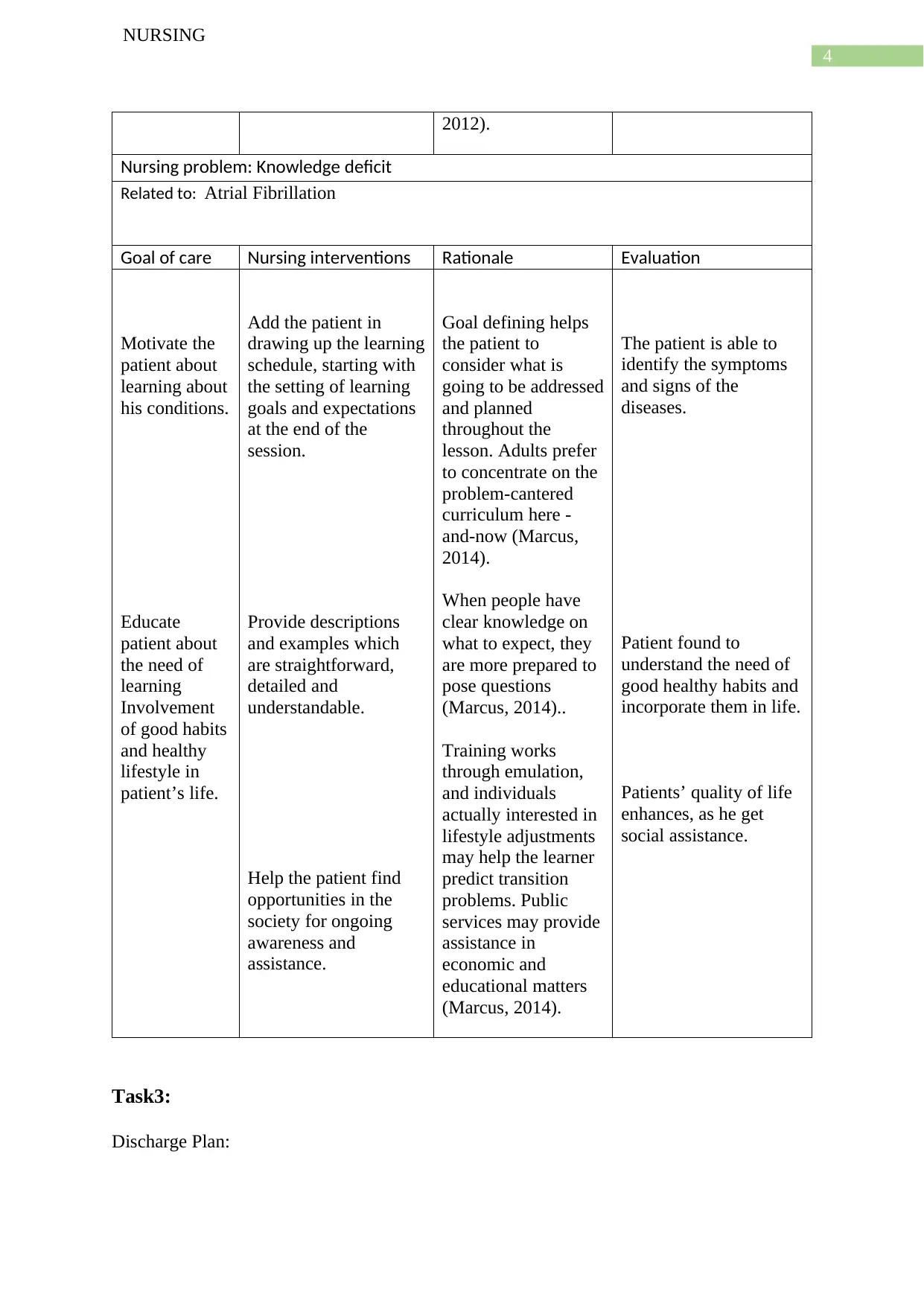
4
NURSING
2012).
Nursing problem: Knowledge deficit
Related to: Atrial Fibrillation
Goal of care Nursing interventions Rationale Evaluation
Motivate the
patient about
learning about
his conditions.
Educate
patient about
the need of
learning
Involvement
of good habits
and healthy
lifestyle in
patient’s life.
Add the patient in
drawing up the learning
schedule, starting with
the setting of learning
goals and expectations
at the end of the
session.
Provide descriptions
and examples which
are straightforward,
detailed and
understandable.
Help the patient find
opportunities in the
society for ongoing
awareness and
assistance.
Goal defining helps
the patient to
consider what is
going to be addressed
and planned
throughout the
lesson. Adults prefer
to concentrate on the
problem-cantered
curriculum here -
and-now (Marcus,
2014).
When people have
clear knowledge on
what to expect, they
are more prepared to
pose questions
(Marcus, 2014)..
Training works
through emulation,
and individuals
actually interested in
lifestyle adjustments
may help the learner
predict transition
problems. Public
services may provide
assistance in
economic and
educational matters
(Marcus, 2014).
The patient is able to
identify the symptoms
and signs of the
diseases.
Patient found to
understand the need of
good healthy habits and
incorporate them in life.
Patients’ quality of life
enhances, as he get
social assistance.
Task3:
Discharge Plan:
NURSING
2012).
Nursing problem: Knowledge deficit
Related to: Atrial Fibrillation
Goal of care Nursing interventions Rationale Evaluation
Motivate the
patient about
learning about
his conditions.
Educate
patient about
the need of
learning
Involvement
of good habits
and healthy
lifestyle in
patient’s life.
Add the patient in
drawing up the learning
schedule, starting with
the setting of learning
goals and expectations
at the end of the
session.
Provide descriptions
and examples which
are straightforward,
detailed and
understandable.
Help the patient find
opportunities in the
society for ongoing
awareness and
assistance.
Goal defining helps
the patient to
consider what is
going to be addressed
and planned
throughout the
lesson. Adults prefer
to concentrate on the
problem-cantered
curriculum here -
and-now (Marcus,
2014).
When people have
clear knowledge on
what to expect, they
are more prepared to
pose questions
(Marcus, 2014)..
Training works
through emulation,
and individuals
actually interested in
lifestyle adjustments
may help the learner
predict transition
problems. Public
services may provide
assistance in
economic and
educational matters
(Marcus, 2014).
The patient is able to
identify the symptoms
and signs of the
diseases.
Patient found to
understand the need of
good healthy habits and
incorporate them in life.
Patients’ quality of life
enhances, as he get
social assistance.
Task3:
Discharge Plan:
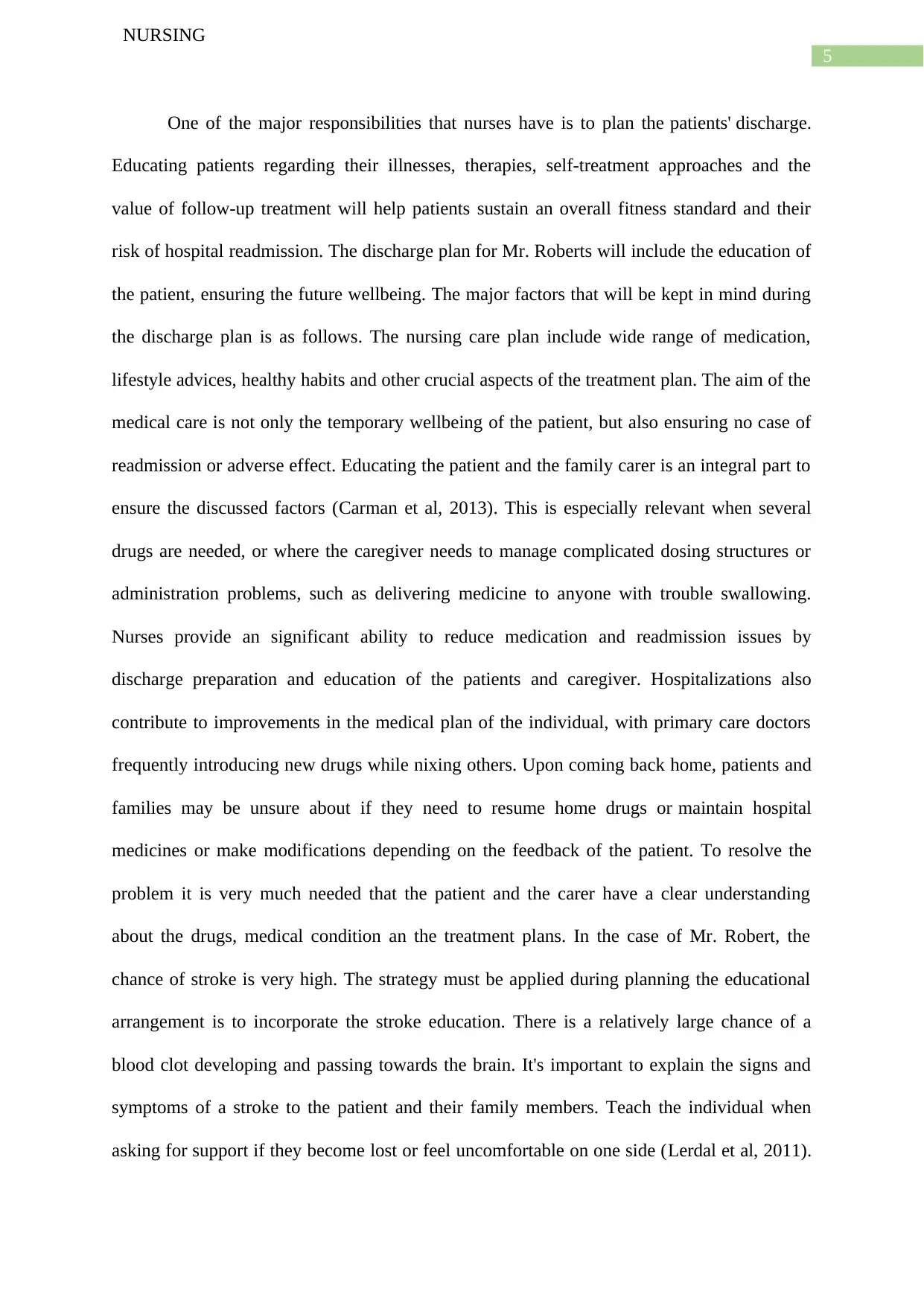
5
NURSING
One of the major responsibilities that nurses have is to plan the patients' discharge.
Educating patients regarding their illnesses, therapies, self-treatment approaches and the
value of follow-up treatment will help patients sustain an overall fitness standard and their
risk of hospital readmission. The discharge plan for Mr. Roberts will include the education of
the patient, ensuring the future wellbeing. The major factors that will be kept in mind during
the discharge plan is as follows. The nursing care plan include wide range of medication,
lifestyle advices, healthy habits and other crucial aspects of the treatment plan. The aim of the
medical care is not only the temporary wellbeing of the patient, but also ensuring no case of
readmission or adverse effect. Educating the patient and the family carer is an integral part to
ensure the discussed factors (Carman et al, 2013). This is especially relevant when several
drugs are needed, or where the caregiver needs to manage complicated dosing structures or
administration problems, such as delivering medicine to anyone with trouble swallowing.
Nurses provide an significant ability to reduce medication and readmission issues by
discharge preparation and education of the patients and caregiver. Hospitalizations also
contribute to improvements in the medical plan of the individual, with primary care doctors
frequently introducing new drugs while nixing others. Upon coming back home, patients and
families may be unsure about if they need to resume home drugs or maintain hospital
medicines or make modifications depending on the feedback of the patient. To resolve the
problem it is very much needed that the patient and the carer have a clear understanding
about the drugs, medical condition an the treatment plans. In the case of Mr. Robert, the
chance of stroke is very high. The strategy must be applied during planning the educational
arrangement is to incorporate the stroke education. There is a relatively large chance of a
blood clot developing and passing towards the brain. It's important to explain the signs and
symptoms of a stroke to the patient and their family members. Teach the individual when
asking for support if they become lost or feel uncomfortable on one side (Lerdal et al, 2011).
NURSING
One of the major responsibilities that nurses have is to plan the patients' discharge.
Educating patients regarding their illnesses, therapies, self-treatment approaches and the
value of follow-up treatment will help patients sustain an overall fitness standard and their
risk of hospital readmission. The discharge plan for Mr. Roberts will include the education of
the patient, ensuring the future wellbeing. The major factors that will be kept in mind during
the discharge plan is as follows. The nursing care plan include wide range of medication,
lifestyle advices, healthy habits and other crucial aspects of the treatment plan. The aim of the
medical care is not only the temporary wellbeing of the patient, but also ensuring no case of
readmission or adverse effect. Educating the patient and the family carer is an integral part to
ensure the discussed factors (Carman et al, 2013). This is especially relevant when several
drugs are needed, or where the caregiver needs to manage complicated dosing structures or
administration problems, such as delivering medicine to anyone with trouble swallowing.
Nurses provide an significant ability to reduce medication and readmission issues by
discharge preparation and education of the patients and caregiver. Hospitalizations also
contribute to improvements in the medical plan of the individual, with primary care doctors
frequently introducing new drugs while nixing others. Upon coming back home, patients and
families may be unsure about if they need to resume home drugs or maintain hospital
medicines or make modifications depending on the feedback of the patient. To resolve the
problem it is very much needed that the patient and the carer have a clear understanding
about the drugs, medical condition an the treatment plans. In the case of Mr. Robert, the
chance of stroke is very high. The strategy must be applied during planning the educational
arrangement is to incorporate the stroke education. There is a relatively large chance of a
blood clot developing and passing towards the brain. It's important to explain the signs and
symptoms of a stroke to the patient and their family members. Teach the individual when
asking for support if they become lost or feel uncomfortable on one side (Lerdal et al, 2011).
⊘ This is a preview!⊘
Do you want full access?
Subscribe today to unlock all pages.

Trusted by 1+ million students worldwide
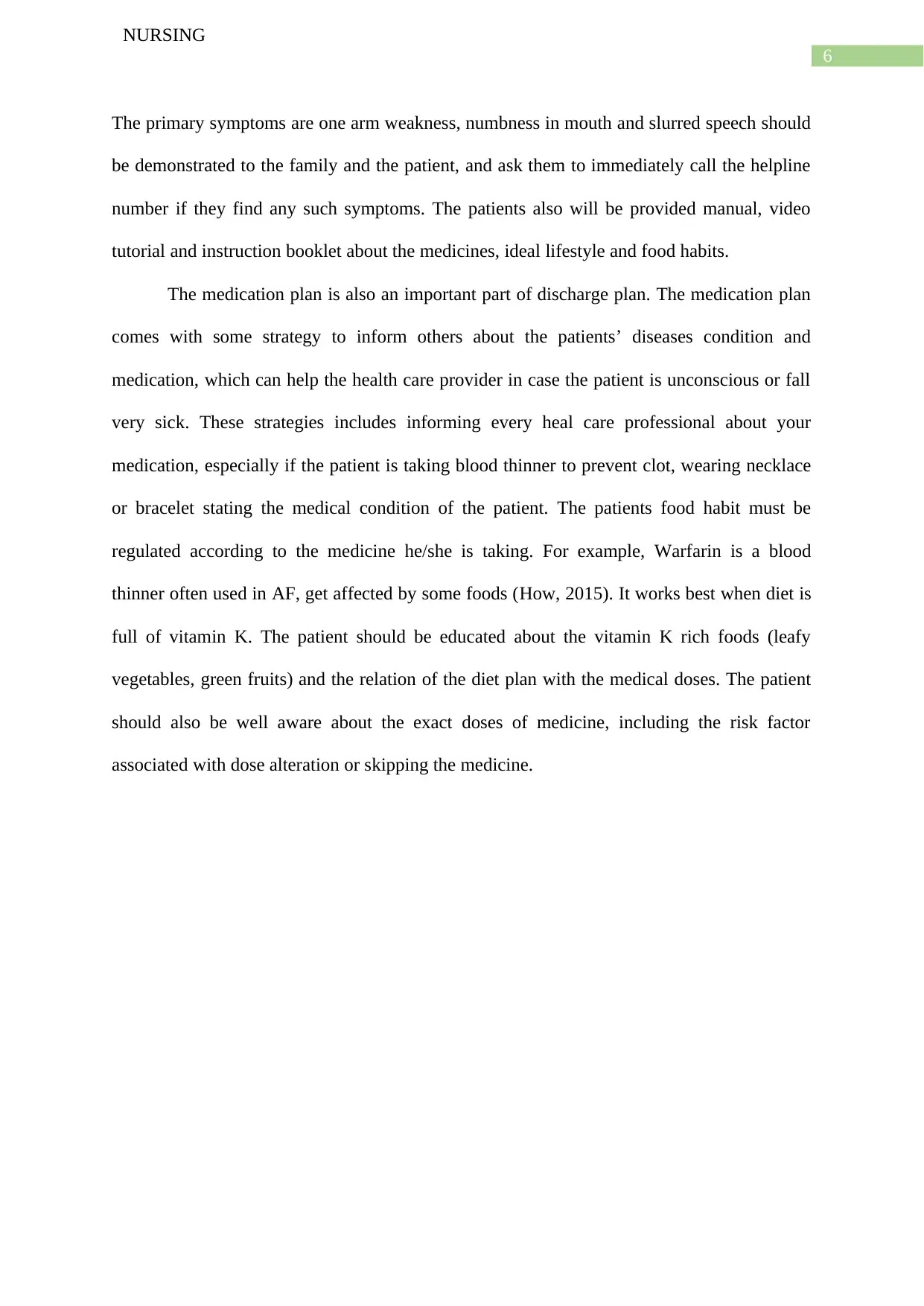
6
NURSING
The primary symptoms are one arm weakness, numbness in mouth and slurred speech should
be demonstrated to the family and the patient, and ask them to immediately call the helpline
number if they find any such symptoms. The patients also will be provided manual, video
tutorial and instruction booklet about the medicines, ideal lifestyle and food habits.
The medication plan is also an important part of discharge plan. The medication plan
comes with some strategy to inform others about the patients’ diseases condition and
medication, which can help the health care provider in case the patient is unconscious or fall
very sick. These strategies includes informing every heal care professional about your
medication, especially if the patient is taking blood thinner to prevent clot, wearing necklace
or bracelet stating the medical condition of the patient. The patients food habit must be
regulated according to the medicine he/she is taking. For example, Warfarin is a blood
thinner often used in AF, get affected by some foods (How, 2015). It works best when diet is
full of vitamin K. The patient should be educated about the vitamin K rich foods (leafy
vegetables, green fruits) and the relation of the diet plan with the medical doses. The patient
should also be well aware about the exact doses of medicine, including the risk factor
associated with dose alteration or skipping the medicine.
NURSING
The primary symptoms are one arm weakness, numbness in mouth and slurred speech should
be demonstrated to the family and the patient, and ask them to immediately call the helpline
number if they find any such symptoms. The patients also will be provided manual, video
tutorial and instruction booklet about the medicines, ideal lifestyle and food habits.
The medication plan is also an important part of discharge plan. The medication plan
comes with some strategy to inform others about the patients’ diseases condition and
medication, which can help the health care provider in case the patient is unconscious or fall
very sick. These strategies includes informing every heal care professional about your
medication, especially if the patient is taking blood thinner to prevent clot, wearing necklace
or bracelet stating the medical condition of the patient. The patients food habit must be
regulated according to the medicine he/she is taking. For example, Warfarin is a blood
thinner often used in AF, get affected by some foods (How, 2015). It works best when diet is
full of vitamin K. The patient should be educated about the vitamin K rich foods (leafy
vegetables, green fruits) and the relation of the diet plan with the medical doses. The patient
should also be well aware about the exact doses of medicine, including the risk factor
associated with dose alteration or skipping the medicine.
Paraphrase This Document
Need a fresh take? Get an instant paraphrase of this document with our AI Paraphraser
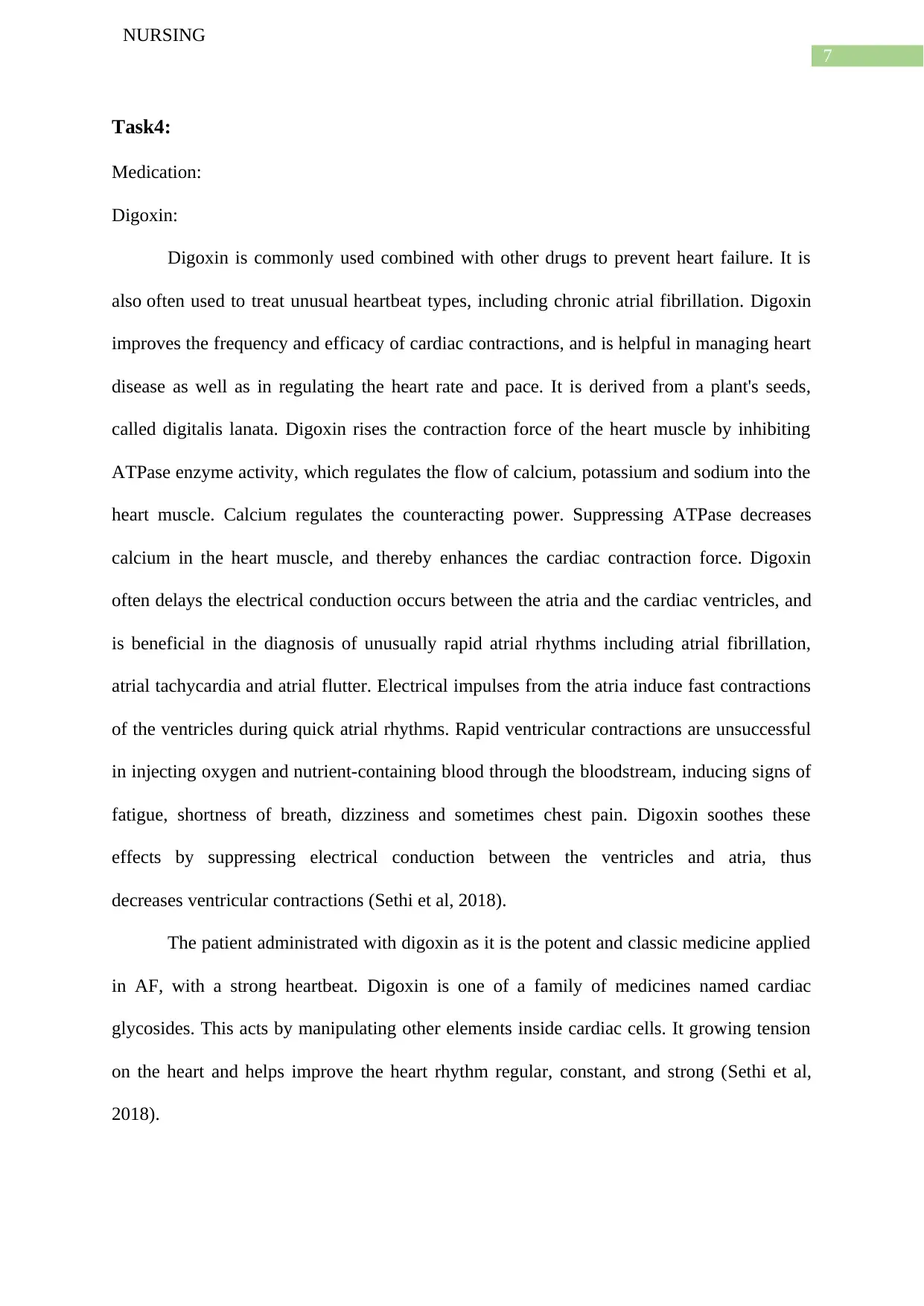
7
NURSING
Task4:
Medication:
Digoxin:
Digoxin is commonly used combined with other drugs to prevent heart failure. It is
also often used to treat unusual heartbeat types, including chronic atrial fibrillation. Digoxin
improves the frequency and efficacy of cardiac contractions, and is helpful in managing heart
disease as well as in regulating the heart rate and pace. It is derived from a plant's seeds,
called digitalis lanata. Digoxin rises the contraction force of the heart muscle by inhibiting
ATPase enzyme activity, which regulates the flow of calcium, potassium and sodium into the
heart muscle. Calcium regulates the counteracting power. Suppressing ATPase decreases
calcium in the heart muscle, and thereby enhances the cardiac contraction force. Digoxin
often delays the electrical conduction occurs between the atria and the cardiac ventricles, and
is beneficial in the diagnosis of unusually rapid atrial rhythms including atrial fibrillation,
atrial tachycardia and atrial flutter. Electrical impulses from the atria induce fast contractions
of the ventricles during quick atrial rhythms. Rapid ventricular contractions are unsuccessful
in injecting oxygen and nutrient-containing blood through the bloodstream, inducing signs of
fatigue, shortness of breath, dizziness and sometimes chest pain. Digoxin soothes these
effects by suppressing electrical conduction between the ventricles and atria, thus
decreases ventricular contractions (Sethi et al, 2018).
The patient administrated with digoxin as it is the potent and classic medicine applied
in AF, with a strong heartbeat. Digoxin is one of a family of medicines named cardiac
glycosides. This acts by manipulating other elements inside cardiac cells. It growing tension
on the heart and helps improve the heart rhythm regular, constant, and strong (Sethi et al,
2018).
NURSING
Task4:
Medication:
Digoxin:
Digoxin is commonly used combined with other drugs to prevent heart failure. It is
also often used to treat unusual heartbeat types, including chronic atrial fibrillation. Digoxin
improves the frequency and efficacy of cardiac contractions, and is helpful in managing heart
disease as well as in regulating the heart rate and pace. It is derived from a plant's seeds,
called digitalis lanata. Digoxin rises the contraction force of the heart muscle by inhibiting
ATPase enzyme activity, which regulates the flow of calcium, potassium and sodium into the
heart muscle. Calcium regulates the counteracting power. Suppressing ATPase decreases
calcium in the heart muscle, and thereby enhances the cardiac contraction force. Digoxin
often delays the electrical conduction occurs between the atria and the cardiac ventricles, and
is beneficial in the diagnosis of unusually rapid atrial rhythms including atrial fibrillation,
atrial tachycardia and atrial flutter. Electrical impulses from the atria induce fast contractions
of the ventricles during quick atrial rhythms. Rapid ventricular contractions are unsuccessful
in injecting oxygen and nutrient-containing blood through the bloodstream, inducing signs of
fatigue, shortness of breath, dizziness and sometimes chest pain. Digoxin soothes these
effects by suppressing electrical conduction between the ventricles and atria, thus
decreases ventricular contractions (Sethi et al, 2018).
The patient administrated with digoxin as it is the potent and classic medicine applied
in AF, with a strong heartbeat. Digoxin is one of a family of medicines named cardiac
glycosides. This acts by manipulating other elements inside cardiac cells. It growing tension
on the heart and helps improve the heart rhythm regular, constant, and strong (Sethi et al,
2018).
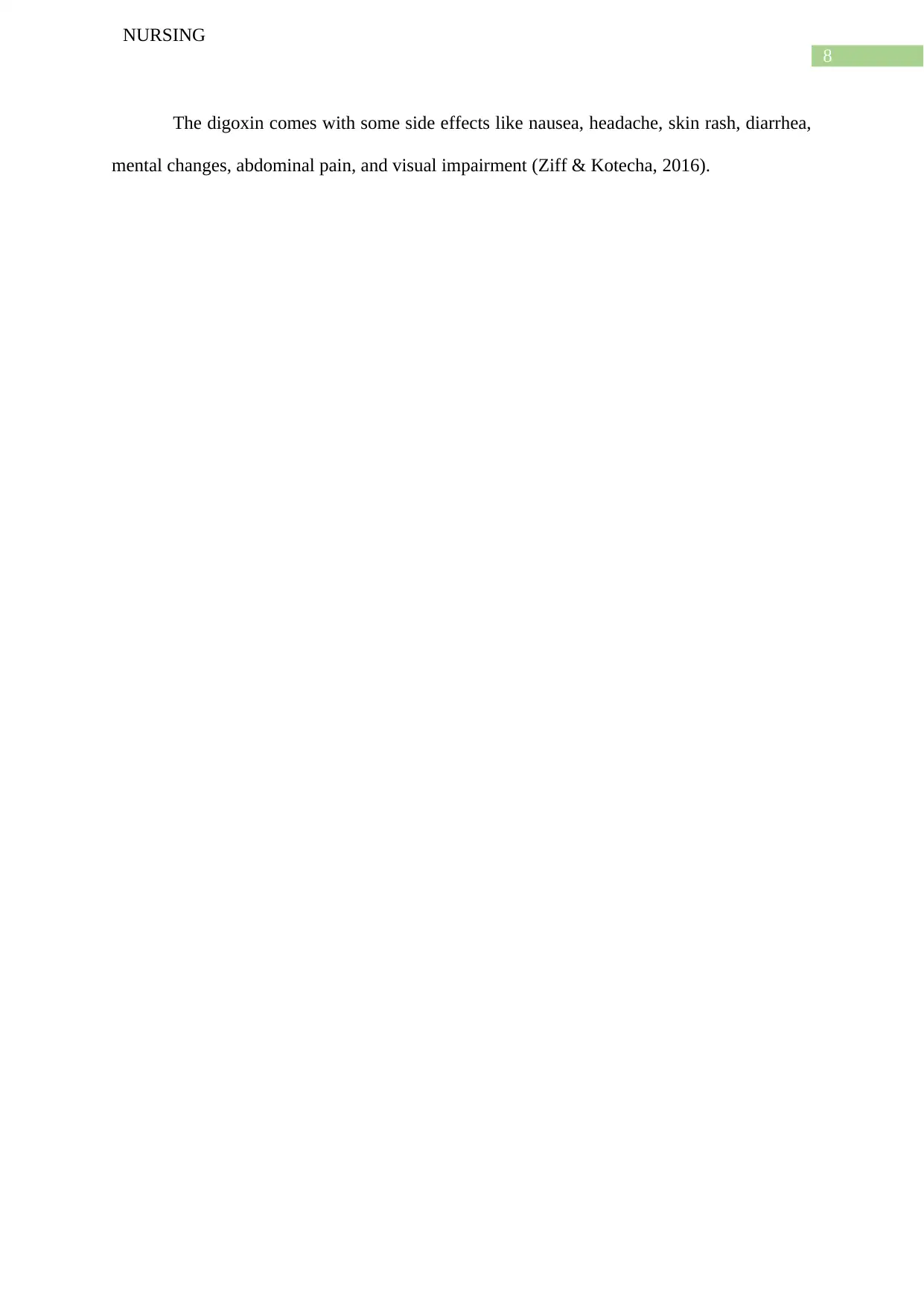
8
NURSING
The digoxin comes with some side effects like nausea, headache, skin rash, diarrhea,
mental changes, abdominal pain, and visual impairment (Ziff & Kotecha, 2016).
NURSING
The digoxin comes with some side effects like nausea, headache, skin rash, diarrhea,
mental changes, abdominal pain, and visual impairment (Ziff & Kotecha, 2016).
⊘ This is a preview!⊘
Do you want full access?
Subscribe today to unlock all pages.

Trusted by 1+ million students worldwide
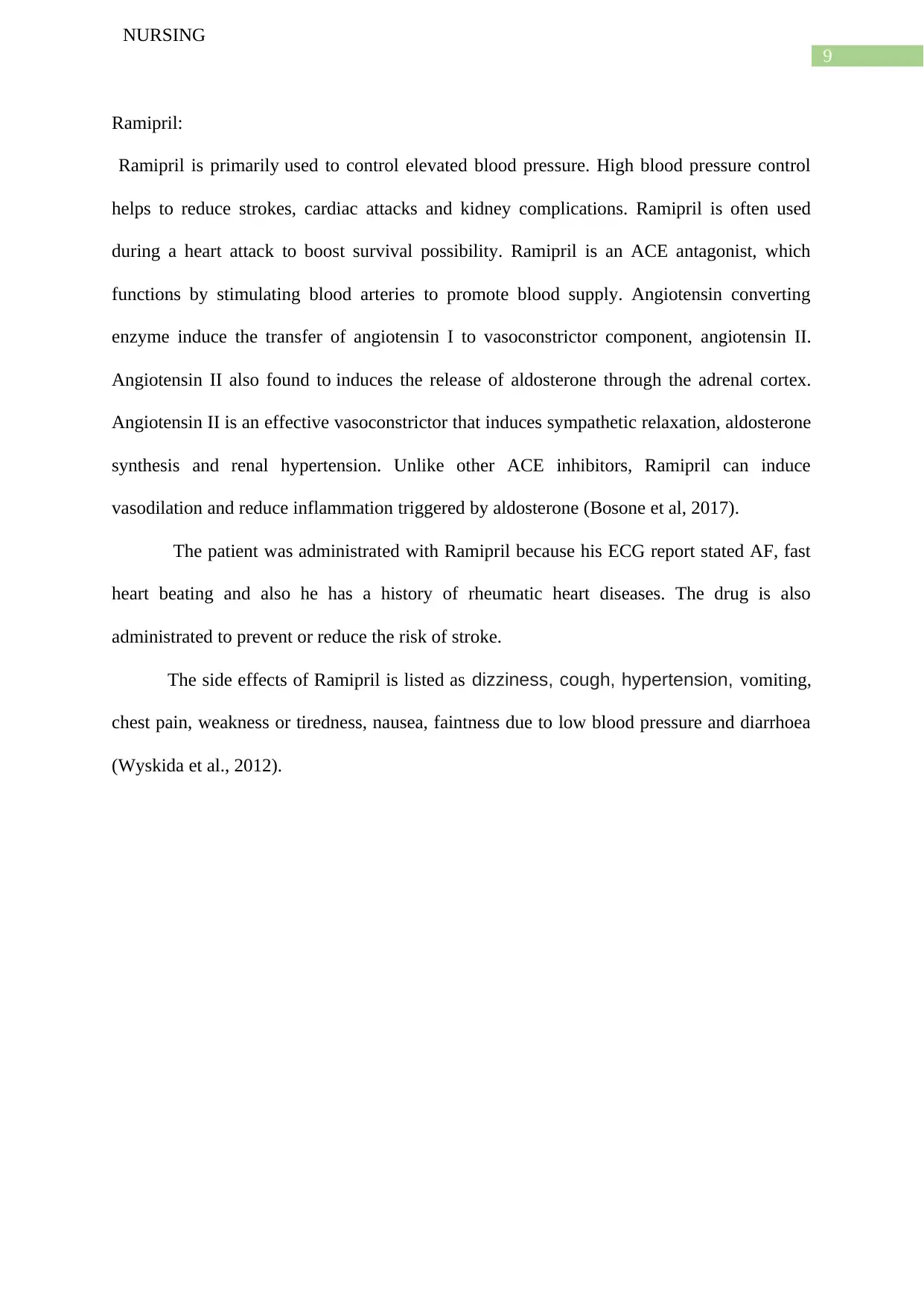
9
NURSING
Ramipril:
Ramipril is primarily used to control elevated blood pressure. High blood pressure control
helps to reduce strokes, cardiac attacks and kidney complications. Ramipril is often used
during a heart attack to boost survival possibility. Ramipril is an ACE antagonist, which
functions by stimulating blood arteries to promote blood supply. Angiotensin converting
enzyme induce the transfer of angiotensin I to vasoconstrictor component, angiotensin II.
Angiotensin II also found to induces the release of aldosterone through the adrenal cortex.
Angiotensin II is an effective vasoconstrictor that induces sympathetic relaxation, aldosterone
synthesis and renal hypertension. Unlike other ACE inhibitors, Ramipril can induce
vasodilation and reduce inflammation triggered by aldosterone (Bosone et al, 2017).
The patient was administrated with Ramipril because his ECG report stated AF, fast
heart beating and also he has a history of rheumatic heart diseases. The drug is also
administrated to prevent or reduce the risk of stroke.
The side effects of Ramipril is listed as dizziness, cough, hypertension, vomiting,
chest pain, weakness or tiredness, nausea, faintness due to low blood pressure and diarrhoea
(Wyskida et al., 2012).
NURSING
Ramipril:
Ramipril is primarily used to control elevated blood pressure. High blood pressure control
helps to reduce strokes, cardiac attacks and kidney complications. Ramipril is often used
during a heart attack to boost survival possibility. Ramipril is an ACE antagonist, which
functions by stimulating blood arteries to promote blood supply. Angiotensin converting
enzyme induce the transfer of angiotensin I to vasoconstrictor component, angiotensin II.
Angiotensin II also found to induces the release of aldosterone through the adrenal cortex.
Angiotensin II is an effective vasoconstrictor that induces sympathetic relaxation, aldosterone
synthesis and renal hypertension. Unlike other ACE inhibitors, Ramipril can induce
vasodilation and reduce inflammation triggered by aldosterone (Bosone et al, 2017).
The patient was administrated with Ramipril because his ECG report stated AF, fast
heart beating and also he has a history of rheumatic heart diseases. The drug is also
administrated to prevent or reduce the risk of stroke.
The side effects of Ramipril is listed as dizziness, cough, hypertension, vomiting,
chest pain, weakness or tiredness, nausea, faintness due to low blood pressure and diarrhoea
(Wyskida et al., 2012).
Paraphrase This Document
Need a fresh take? Get an instant paraphrase of this document with our AI Paraphraser
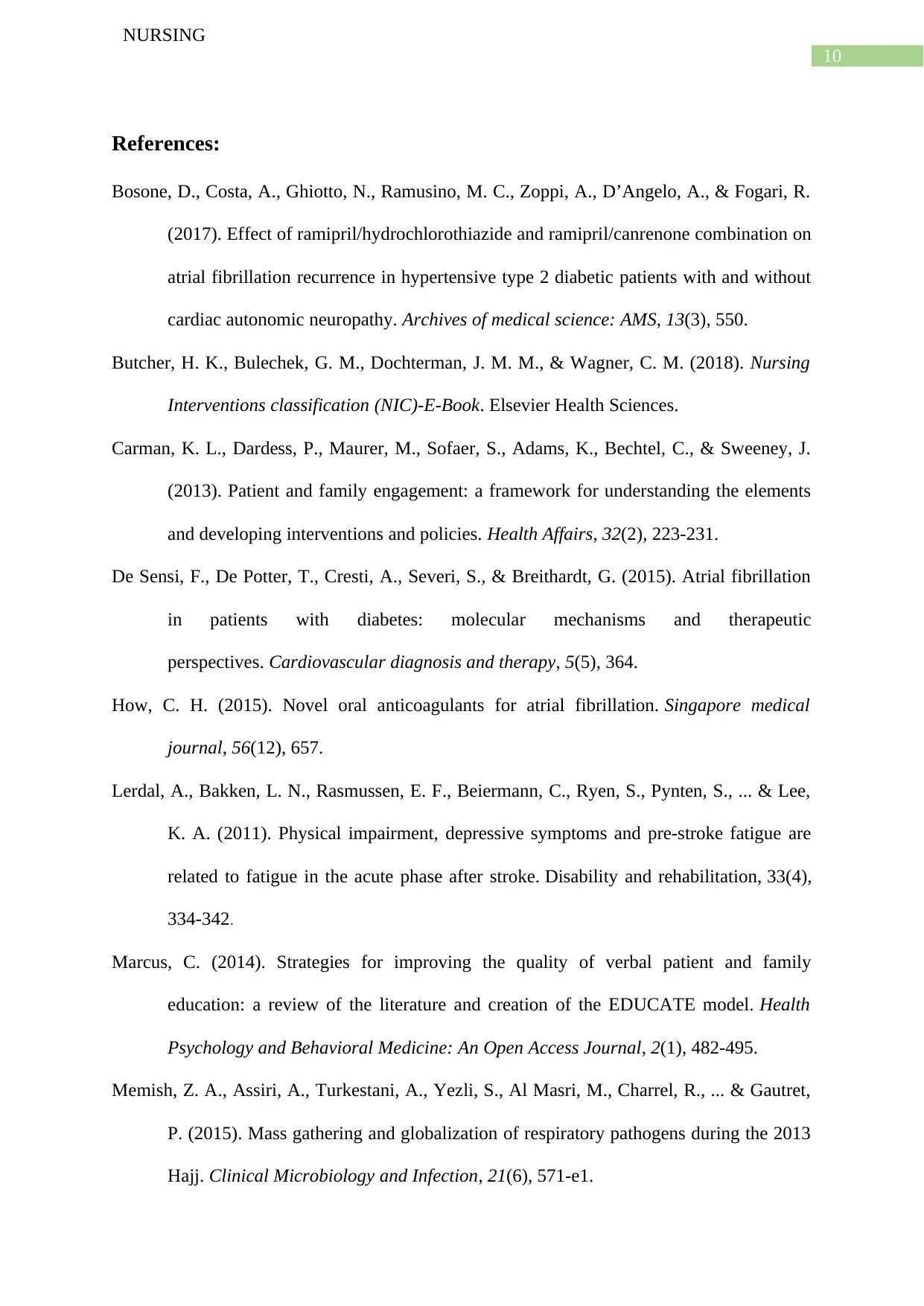
10
NURSING
References:
Bosone, D., Costa, A., Ghiotto, N., Ramusino, M. C., Zoppi, A., D’Angelo, A., & Fogari, R.
(2017). Effect of ramipril/hydrochlorothiazide and ramipril/canrenone combination on
atrial fibrillation recurrence in hypertensive type 2 diabetic patients with and without
cardiac autonomic neuropathy. Archives of medical science: AMS, 13(3), 550.
Butcher, H. K., Bulechek, G. M., Dochterman, J. M. M., & Wagner, C. M. (2018). Nursing
Interventions classification (NIC)-E-Book. Elsevier Health Sciences.
Carman, K. L., Dardess, P., Maurer, M., Sofaer, S., Adams, K., Bechtel, C., & Sweeney, J.
(2013). Patient and family engagement: a framework for understanding the elements
and developing interventions and policies. Health Affairs, 32(2), 223-231.
De Sensi, F., De Potter, T., Cresti, A., Severi, S., & Breithardt, G. (2015). Atrial fibrillation
in patients with diabetes: molecular mechanisms and therapeutic
perspectives. Cardiovascular diagnosis and therapy, 5(5), 364.
How, C. H. (2015). Novel oral anticoagulants for atrial fibrillation. Singapore medical
journal, 56(12), 657.
Lerdal, A., Bakken, L. N., Rasmussen, E. F., Beiermann, C., Ryen, S., Pynten, S., ... & Lee,
K. A. (2011). Physical impairment, depressive symptoms and pre-stroke fatigue are
related to fatigue in the acute phase after stroke. Disability and rehabilitation, 33(4),
334-342.
Marcus, C. (2014). Strategies for improving the quality of verbal patient and family
education: a review of the literature and creation of the EDUCATE model. Health
Psychology and Behavioral Medicine: An Open Access Journal, 2(1), 482-495.
Memish, Z. A., Assiri, A., Turkestani, A., Yezli, S., Al Masri, M., Charrel, R., ... & Gautret,
P. (2015). Mass gathering and globalization of respiratory pathogens during the 2013
Hajj. Clinical Microbiology and Infection, 21(6), 571-e1.
NURSING
References:
Bosone, D., Costa, A., Ghiotto, N., Ramusino, M. C., Zoppi, A., D’Angelo, A., & Fogari, R.
(2017). Effect of ramipril/hydrochlorothiazide and ramipril/canrenone combination on
atrial fibrillation recurrence in hypertensive type 2 diabetic patients with and without
cardiac autonomic neuropathy. Archives of medical science: AMS, 13(3), 550.
Butcher, H. K., Bulechek, G. M., Dochterman, J. M. M., & Wagner, C. M. (2018). Nursing
Interventions classification (NIC)-E-Book. Elsevier Health Sciences.
Carman, K. L., Dardess, P., Maurer, M., Sofaer, S., Adams, K., Bechtel, C., & Sweeney, J.
(2013). Patient and family engagement: a framework for understanding the elements
and developing interventions and policies. Health Affairs, 32(2), 223-231.
De Sensi, F., De Potter, T., Cresti, A., Severi, S., & Breithardt, G. (2015). Atrial fibrillation
in patients with diabetes: molecular mechanisms and therapeutic
perspectives. Cardiovascular diagnosis and therapy, 5(5), 364.
How, C. H. (2015). Novel oral anticoagulants for atrial fibrillation. Singapore medical
journal, 56(12), 657.
Lerdal, A., Bakken, L. N., Rasmussen, E. F., Beiermann, C., Ryen, S., Pynten, S., ... & Lee,
K. A. (2011). Physical impairment, depressive symptoms and pre-stroke fatigue are
related to fatigue in the acute phase after stroke. Disability and rehabilitation, 33(4),
334-342.
Marcus, C. (2014). Strategies for improving the quality of verbal patient and family
education: a review of the literature and creation of the EDUCATE model. Health
Psychology and Behavioral Medicine: An Open Access Journal, 2(1), 482-495.
Memish, Z. A., Assiri, A., Turkestani, A., Yezli, S., Al Masri, M., Charrel, R., ... & Gautret,
P. (2015). Mass gathering and globalization of respiratory pathogens during the 2013
Hajj. Clinical Microbiology and Infection, 21(6), 571-e1.
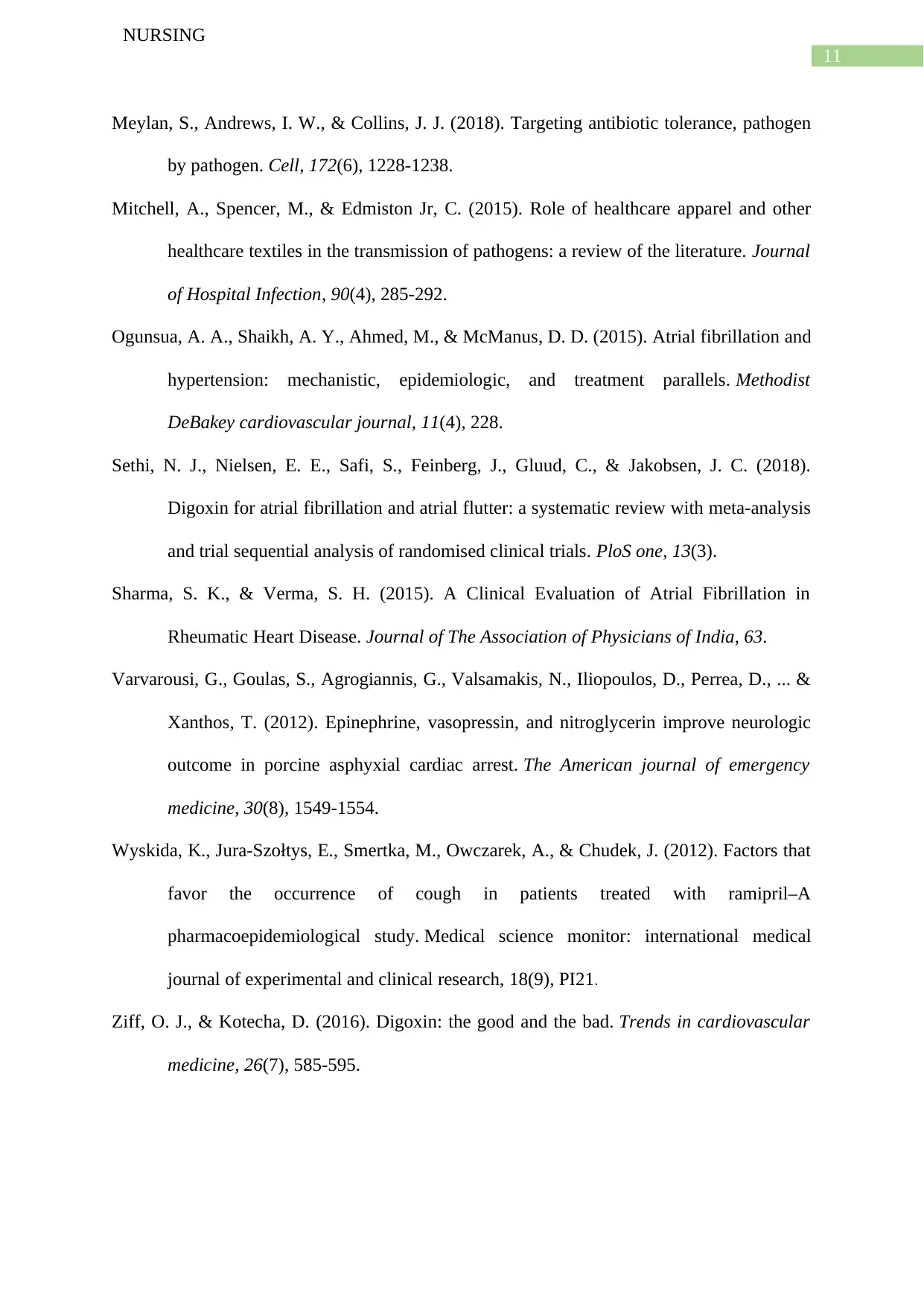
11
NURSING
Meylan, S., Andrews, I. W., & Collins, J. J. (2018). Targeting antibiotic tolerance, pathogen
by pathogen. Cell, 172(6), 1228-1238.
Mitchell, A., Spencer, M., & Edmiston Jr, C. (2015). Role of healthcare apparel and other
healthcare textiles in the transmission of pathogens: a review of the literature. Journal
of Hospital Infection, 90(4), 285-292.
Ogunsua, A. A., Shaikh, A. Y., Ahmed, M., & McManus, D. D. (2015). Atrial fibrillation and
hypertension: mechanistic, epidemiologic, and treatment parallels. Methodist
DeBakey cardiovascular journal, 11(4), 228.
Sethi, N. J., Nielsen, E. E., Safi, S., Feinberg, J., Gluud, C., & Jakobsen, J. C. (2018).
Digoxin for atrial fibrillation and atrial flutter: a systematic review with meta-analysis
and trial sequential analysis of randomised clinical trials. PloS one, 13(3).
Sharma, S. K., & Verma, S. H. (2015). A Clinical Evaluation of Atrial Fibrillation in
Rheumatic Heart Disease. Journal of The Association of Physicians of India, 63.
Varvarousi, G., Goulas, S., Agrogiannis, G., Valsamakis, N., Iliopoulos, D., Perrea, D., ... &
Xanthos, T. (2012). Epinephrine, vasopressin, and nitroglycerin improve neurologic
outcome in porcine asphyxial cardiac arrest. The American journal of emergency
medicine, 30(8), 1549-1554.
Wyskida, K., Jura-Szołtys, E., Smertka, M., Owczarek, A., & Chudek, J. (2012). Factors that
favor the occurrence of cough in patients treated with ramipril–A
pharmacoepidemiological study. Medical science monitor: international medical
journal of experimental and clinical research, 18(9), PI21.
Ziff, O. J., & Kotecha, D. (2016). Digoxin: the good and the bad. Trends in cardiovascular
medicine, 26(7), 585-595.
NURSING
Meylan, S., Andrews, I. W., & Collins, J. J. (2018). Targeting antibiotic tolerance, pathogen
by pathogen. Cell, 172(6), 1228-1238.
Mitchell, A., Spencer, M., & Edmiston Jr, C. (2015). Role of healthcare apparel and other
healthcare textiles in the transmission of pathogens: a review of the literature. Journal
of Hospital Infection, 90(4), 285-292.
Ogunsua, A. A., Shaikh, A. Y., Ahmed, M., & McManus, D. D. (2015). Atrial fibrillation and
hypertension: mechanistic, epidemiologic, and treatment parallels. Methodist
DeBakey cardiovascular journal, 11(4), 228.
Sethi, N. J., Nielsen, E. E., Safi, S., Feinberg, J., Gluud, C., & Jakobsen, J. C. (2018).
Digoxin for atrial fibrillation and atrial flutter: a systematic review with meta-analysis
and trial sequential analysis of randomised clinical trials. PloS one, 13(3).
Sharma, S. K., & Verma, S. H. (2015). A Clinical Evaluation of Atrial Fibrillation in
Rheumatic Heart Disease. Journal of The Association of Physicians of India, 63.
Varvarousi, G., Goulas, S., Agrogiannis, G., Valsamakis, N., Iliopoulos, D., Perrea, D., ... &
Xanthos, T. (2012). Epinephrine, vasopressin, and nitroglycerin improve neurologic
outcome in porcine asphyxial cardiac arrest. The American journal of emergency
medicine, 30(8), 1549-1554.
Wyskida, K., Jura-Szołtys, E., Smertka, M., Owczarek, A., & Chudek, J. (2012). Factors that
favor the occurrence of cough in patients treated with ramipril–A
pharmacoepidemiological study. Medical science monitor: international medical
journal of experimental and clinical research, 18(9), PI21.
Ziff, O. J., & Kotecha, D. (2016). Digoxin: the good and the bad. Trends in cardiovascular
medicine, 26(7), 585-595.
⊘ This is a preview!⊘
Do you want full access?
Subscribe today to unlock all pages.

Trusted by 1+ million students worldwide
1 out of 12
Related Documents
Your All-in-One AI-Powered Toolkit for Academic Success.
+13062052269
info@desklib.com
Available 24*7 on WhatsApp / Email
![[object Object]](/_next/static/media/star-bottom.7253800d.svg)
Unlock your academic potential
Copyright © 2020–2025 A2Z Services. All Rights Reserved. Developed and managed by ZUCOL.





